I have been visiting Bali for decades and felt it's time to explain why I keep coming back. I'll start with a potted history of Bali.
In approximately 2000BC Bali was inhabited by Austronesian people who came via China. They bought with them Indian, Chinese and Hindu culture.In both the 11th and 14th centuries Bali was invaded by the Javanese. When the Javanese left they had the luxury of 100 or so years of peace.
The Portuguese discovered Bali in 1585 when a ship was wrecked off the Bukit Peninsula. They couldn't see any tourist potential and forgot to take time to smell the spices. They went home empty handed and with nowhere to go for Christmas holidays.
In 1597 Cornelis de Houtman, a Dutchman, arrived, hung around, checked the place out and in 1602 established the Dutch East India Company. The Dutch liked Bali so much that they thought they should own part of it.A small part wasn't really enough so in the 1840's they took colonial control of it. Europeans couldn't get enough of sugar and spice and all things nice from Bali. The Balinese had enough of the Netherlands and wanted them gone. In the early 1900's the Balinese rose up against the Dutch. The Dutch retaliated in a most unpleasant way by staging a couple of massacres and killing 1000's of Balinese. A not very funny way to repay their hospitality.
In the 1930's western anthropologists discovered Bali. They declared it to be "an enchanting land of aesthetes at peace with themselves and nature". Thus began an invasion by western tourists who were neither aesthetic, at peace with themselves or at peace with nature.
This ended only twelve years later, as did Dutch rule. It seems that the Balinese should have been happy.
But no. The change occurred because the Japanese invaded. They turned out to be no better that the Dutch, who the Balinese were glad to get rid of. The Japanese also committed massacres and just generally behaved badly.
The Dutch just wouldn't lie down and go to sleep. The Japanese surrendered in 1945 and the Dutch promptly returned. They came back for the sun and surf but mainly the spices. This time the Balinese had all the old weapons left behind from the Japanese and rose up again. But the Dutch, who had plenty of practise, just massacred them . Those who died were unlucky as only four years later the government of the Netherlands acknowledged Indonesia's sovereignty over Bali and left.
Having centuries of invasions and massacres by foreign governments, it would be great to think that peace had finally come to Bali. But now internal politics came into the picture. During the 1950's and 60's the Indonesian army killed over 80,000 Balinese as part of an Indonesian wide effort to put down a political coup.This was around 3% of the Balinese population.
Everything finally settled down in 1966 and Bali breathed a sigh of relief. But they were to be invaded yet again. By Australia surfers.
In the late 1960's and 70's, Bali became the mecca for hippies, surfers, dopers and drop-outs. The generally impoverished student and unemployed traveller. They travelled in Combi Vans and dossed on the beach. They stayed with villagers, eating their meagre food and generally taking advantage of the generosity and hospitality of the Balinese. They felt they were becoming one with nature. This meant they didn't wash. The Balinese thought they were scruffy, dirty, lazy spongers. Their parents back home thought the same and were glad to be rid of them.
The free-loaders who came to Bali in the 60's and 70's now bemoan the loss of innocence of the Balinese. They are annoyed that the island has been opened up with villas and resorts. They are annoyed that wealthy tourists now come to Bali. Tourists who are willing to pay their way. They feel that the west has destroyed the Balinese culture.
This is to underestimate the Balinese. They have withstood so much that they are very resilient. Their temples don't have product placement or merchandising. There is a very private side of Bali that will never be corrupted. Their festivals are not conducted for Kodak moments. They are personal and private. They are still part of village life.
But people can now mostly afford to send their kids to school. Education is not free or a right in Indonesia. Teenagers now have a career path that doesn't include working on a rice terrace. Many of them do work in the service industries but a lot now have ambitions to travel and own their own companies.
The Balinese run a great self-regulated system that simply doesn't need western do-gooders. A good example of this is the control of village water. The villages are organised along the lines of a hierarchy. The top village is at the top of the hill. They are the first to have access to water. Obviously the water then flows down to the lowest the village. But it's the village at the bottom who decides the water allocation for the entire network of villages all the way back to the top. Simple and elegant, this was established practise around 300BC. Westerners came in thinking they could improve the system. After a drought or two the villages reverted back to their own way.
The Western tourist continues to invade, and the true Balinese culture continues to ignore them.
I was too young to join the hippy trail so I don't know what I may have missed. But as I bemoan the developments that I have seen in the passed 20 years I respect the right of the Balinese to modernise and move on.
The following photographs were taken in 1971 by my brother.
.jpg.aspx) Padi fields near Padang Bai
Padi fields near Padang Bai
These are still here and still look like this today.
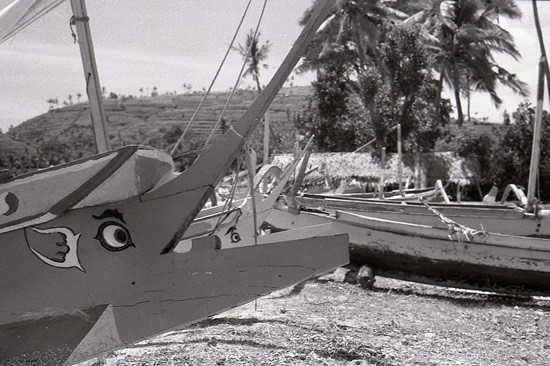 Padang Bai - fishing boats These are still the boats that are being used by local fishermen.
Padang Bai - fishing boats These are still the boats that are being used by local fishermen.
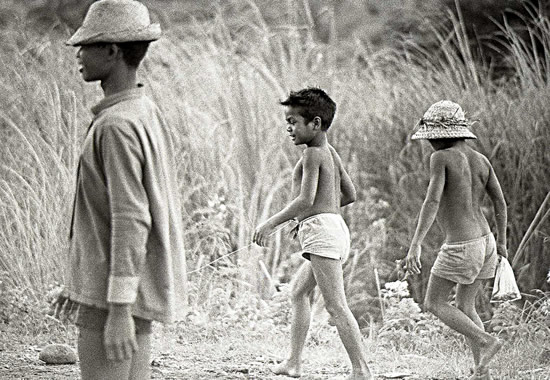 Boys near Padang Bai The local kids still look like this although they may wear board shorts
Boys near Padang Bai The local kids still look like this although they may wear board shorts.
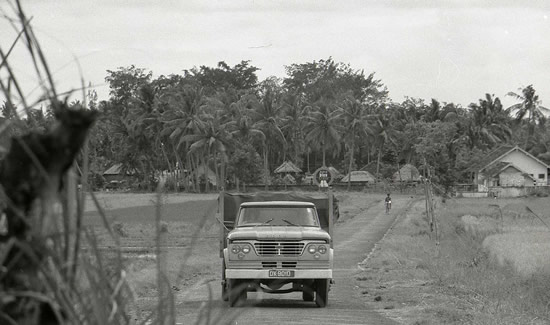 Out to the east - Bali Today that would be a 4-wheel drive and there would be ten times the traffic
Out to the east - Bali Today that would be a 4-wheel drive and there would be ten times the traffic
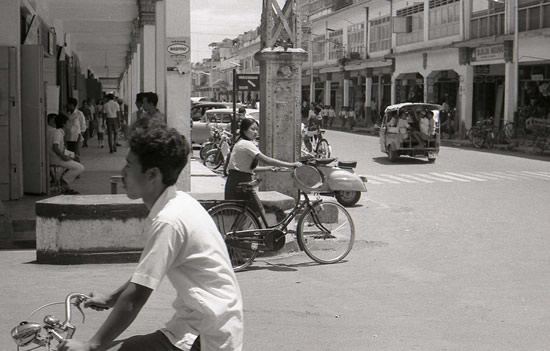 Denpasar - midday This has really changed. Motorbikes have replaced bikes and there would be a snarling, honking traffic jam.
Denpasar - midday This has really changed. Motorbikes have replaced bikes and there would be a snarling, honking traffic jam.
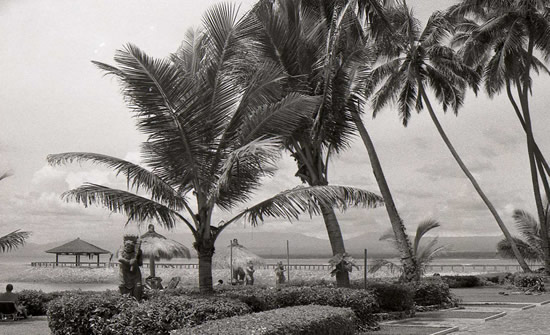 Kuta beach - resort foreshore Kuta is now the worst aspect of tourism in Bali. It is totally built out and is a haven for drunks, beggars and touts.
Kuta beach - resort foreshore Kuta is now the worst aspect of tourism in Bali. It is totally built out and is a haven for drunks, beggars and touts.
 Kuta beach resort foreshore This does look idyllic compared with now.
Kuta beach resort foreshore This does look idyllic compared with now.
 School girls - Denpasar Girls still wear skirts shorter than their mothers would like, although they would probably wearing jeans and a T-Shirt.
School girls - Denpasar Girls still wear skirts shorter than their mothers would like, although they would probably wearing jeans and a T-Shirt.
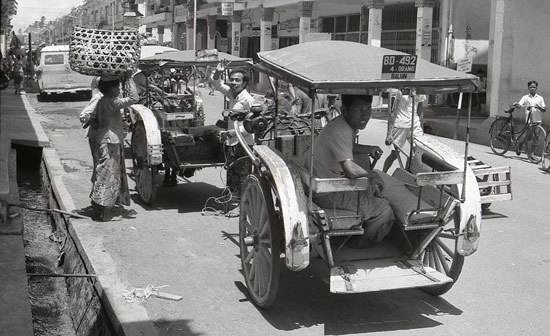 Pre-motor betjak (a tricycle taxi) - Denpasar Now you have annoying cab drivers who constantly ask you "do you have a plan for tomorrow?"
Pre-motor betjak (a tricycle taxi) - Denpasar Now you have annoying cab drivers who constantly ask you "do you have a plan for tomorrow?"
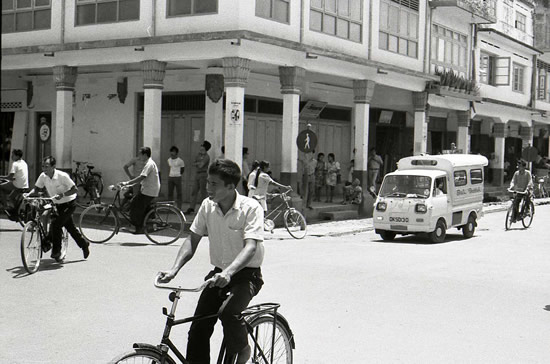 Denpasar traffic jam Maybe it was better back then.
Denpasar traffic jam Maybe it was better back then.
 Not sure where - bus depot farewell and welcoming committee. This looks more like someone begging. With the influx of people from Java this has increased. The Balinese look after their own and begging from Balinese is incredibly rare.
Not sure where - bus depot farewell and welcoming committee. This looks more like someone begging. With the influx of people from Java this has increased. The Balinese look after their own and begging from Balinese is incredibly rare.
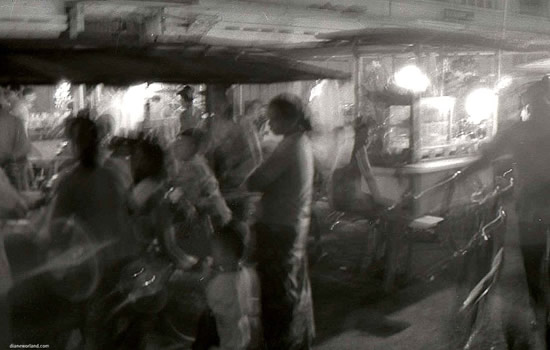 Night market - Denpasar Denpasar is still very local, it is not a tourist hangout.
Night market - Denpasar Denpasar is still very local, it is not a tourist hangout.
 Before the influx of tourists - Singaraja Singaraja although modernised hasn't changed that much. The tourists never came.
Before the influx of tourists - Singaraja Singaraja although modernised hasn't changed that much. The tourists never came.
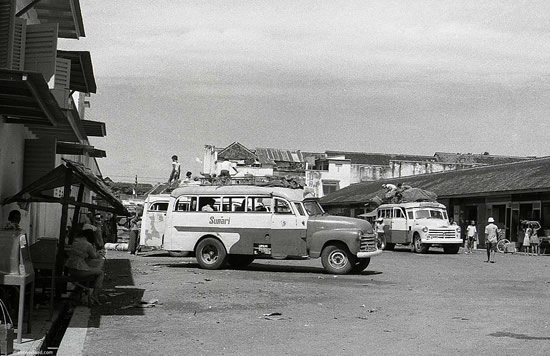 Bus Depot - Singaraja
Bus Depot - Singaraja
 Bus Depot - Singaraja
Bus Depot - Singaraja
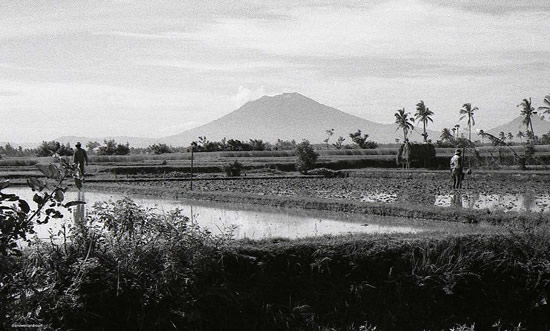 Gunung Agung - Padi fields for sure Little has changed in the countryside as tourism has largely stuck to the coastal areas.
Gunung Agung - Padi fields for sure Little has changed in the countryside as tourism has largely stuck to the coastal areas.
 Kuta resort - with a genuine touch of Balinese temple decoration. These are still used today.
Kuta resort - with a genuine touch of Balinese temple decoration. These are still used today.
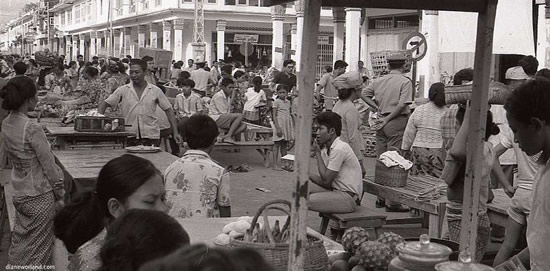
Denpasar street market No-one would close the city centre for a street market now. But you still see this in local villages. Unfortunately the beach markets have been replaced with tacky sheds stuffed with cheap tourist rubbish. And there are now big malls selling duty free garbage that you wouldn't buy at home.

Denpasar street market
So this is my reflection of the past.
Part 2 will bring me into the present.